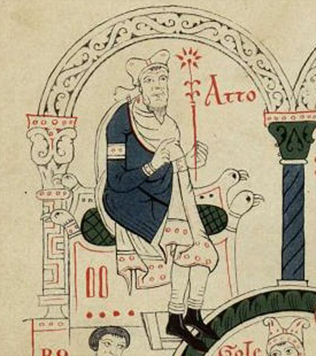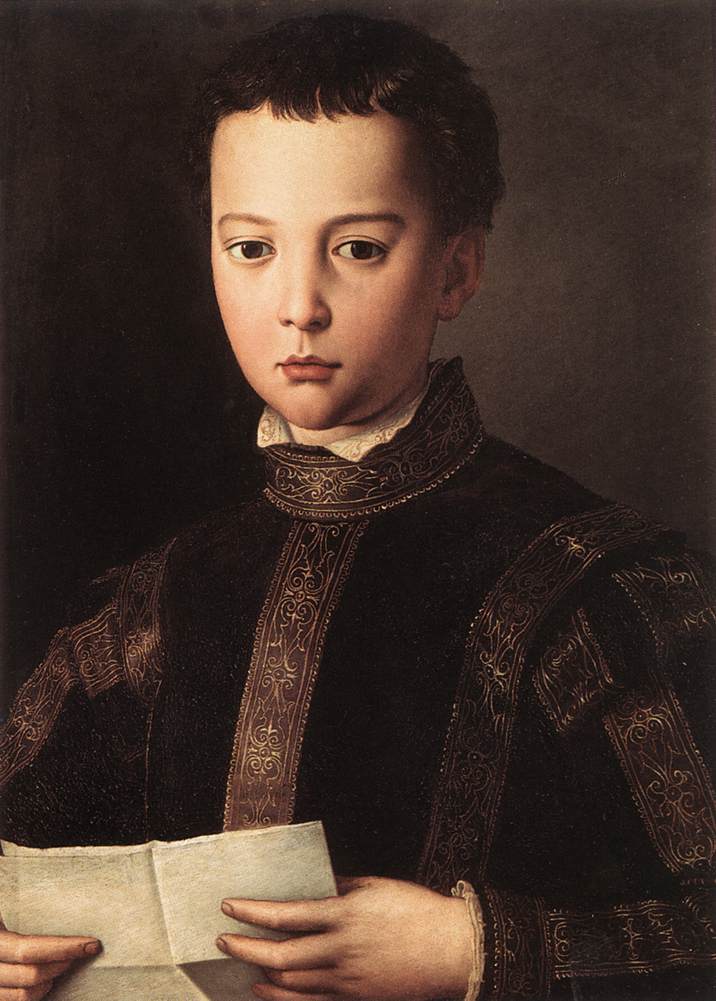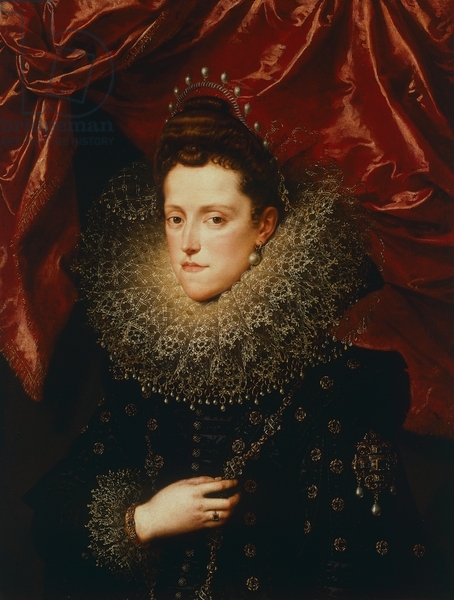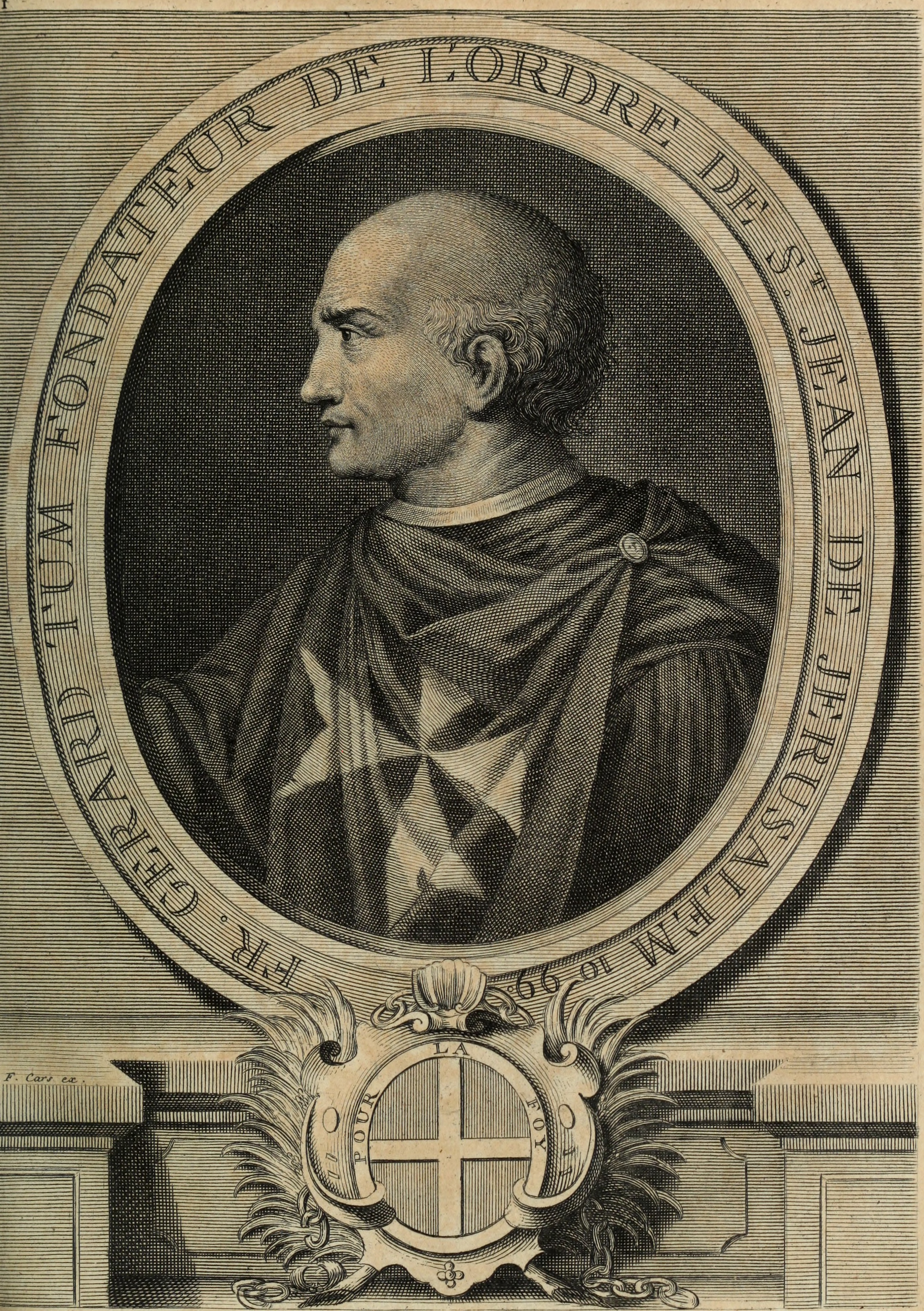|
Vincenzo II Gonzaga
Vincenzo II Gonzaga (8 February 1594 – 25 December 1627) was Duke of Mantua and Duke of Montferrat from 1626 until his death. Vincenzo was the son of Duke Vincent I and Eleonora de' Medici and inherited the duchy upon the death of his elder brother Ferdinand, receiving the imperial investiture on 8 February 1627. He received a cardinalate in 1615 upon Ferdinando's succession, but did not travel to Rome to receive the red hat; the following year he married his relative Isabella Gonzaga, daughter of Alfonso Gonzaga, Count of Novellara, and the pope deprived him of his cardinalate. He and Isabella did not have any children, and as the only surviving son, he was encouraged to take a new wife; however the pope would not grant him a divorce. Isabella was then accused of witchcraft, but was found innocent; three men were later executed for trying to murder her. Vincenzo also had problems with money and sold several of his paintings and valuables, particularly to the English ... [...More Info...] [...Related Items...] OR: [Wikipedia] [Google] [Baidu] |
Duke Of Mantua
During its Timeline of Mantua, history as independent entity, Mantua had different rulers who governed on the city and the lands of Mantua from the Middle Ages to the early modern period. From 970 to 1115, the Counts of Mantua were members of the House of Canossa. During its time as Medieval commune, free commune and ''signoria'' ("lordship"), the Lords of Mantua were exponents of the Bonacolsi and House of Gonzaga, Gonzaga families. From 1328, Mantua was informally led by Gonzagas until 1433, when Gianfrancesco Gonzaga assumed the noble title of Marquess of Mantua. In 1530, Federico II received the title of Duke of Mantua. In 1531, the family acquired the vacant Marquisate of Montferrat through marriage. In 1627, Duke Vincent II deceased without heirs, ending the original line of Gonzagas. From 1628 to 1631, a War of the Mantuan Succession, succession war was fought between the Ferrante II Gonzaga, Duke of Guastalla, Duke of Guastalla, supported by the Holy Roman Empire, and t ... [...More Info...] [...Related Items...] OR: [Wikipedia] [Google] [Baidu] |
Francesco IV Of Gonzaga
Francesco IV Gonzaga (7 May 1586 – 22 December 1612) was Duke of Mantua and Duke of Montferrat, Montferrat between 9 February and 22 December 1612. Biography Born in Mantua, he was the eldest son of Duke Vincenzo I Gonzaga, Vincenzo I and Eleonora de' Medici. In 1607, Claudio Monteverdi dedicated his opera ''L'Orfeo'' to Francesco. The title page of the opera bears the dedication "Al serenissimo signor D. Francesco Gonzaga, Prencipe di Mantoua, & di Monferato, &c." Francesco became Duke upon his father's death on 9 February 1612. He died at Mantua on 22 December 1612 without male heirs. He was succeeded by his brother Ferdinando Gonzaga, Duke of Mantua, Ferdinand; however, Charles Emmanuel I, Duke of Savoy, the father of Francesco's wife Margarida of Savoy, Vicereine of Portugal, Margaret of Savoy, disputed this, leading to the War of the Montferrat Succession (1613–1617). Family On 19 February 1608 he married in Turin, Margarida of Savoy, Vicereine of Portugal, Margaret of S ... [...More Info...] [...Related Items...] OR: [Wikipedia] [Google] [Baidu] |
Margaret Palaeologina
Margaret Palaeologa (; 11 August 1510 – 28 December 1566), was the ruling Marquise regnant of Montferrat in her own right between 1533 and 1536. She was also Duchess of Mantua by marriage to Federico II, Duke of Mantua. Margaret acted as the regent of the Duchy of Mantua twice during the minority of her sons: for her elder son Francesco III Gonzaga, Duke of Mantua in 1540–1549, and for her younger son Guglielmo Gonzaga, Duke of Mantua, between 1550 and 1556. Early life Margaret was born in Casale to William IX of Montferrat and his wife Anne of Alençon. Margaret was the second of three children. Her elder sister was Maria Paleologa, who died when she was 21 years of age, and her younger brother was Boniface IV of Montferrat, who died when he was only 18 years of age. Marriage In 1517, Margaret's elder sister, Maria, was betrothed to Federico II Gonzaga, son of Francesco II Gonzaga and Isabella d'Este, who later became Marquis and Duke of Mantua. Th ... [...More Info...] [...Related Items...] OR: [Wikipedia] [Google] [Baidu] |
Federico II, Duke Of Mantua
Federico II of Gonzaga (17 May 1500 – 28 August 1540) was the ruler of the Italian city of Mantua (first as Marquis, later as Duke) from 1519 until his death. He was also Marquis of Montferrat from 1536. Biography Federico was son of Francesco II Gonzaga, Marquess of Mantua and Isabella d'Este. Due to the turbulent politics of the time, from the age of ten, he spent three years as a hostage in Rome under Pope Julius II. From 1515 to 1517, Federico was the hostage of King Francis I of France, to ensure Gonzaga assistance in Italy. On 3 April 1519, Federico succeeded his father as Marquis of Mantua, initially under the regency of his mother and his uncles Sigismondo and Giovanni Gonzaga. He received the imperial investiture from emperor Charles V on 7 April 1521. Pope Leo X named him Captain General of the Church (commander in chief of the Papal Army) in July 1521, and he fought against the French at Parma in 1521 and at Piacenza in 1522. Federico signed a marriage contract wi ... [...More Info...] [...Related Items...] OR: [Wikipedia] [Google] [Baidu] |
Joanna Of Austria, Grand Duchess Of Tuscany
Joanna is a feminine given name deriving from from . Variants in English include Joan, Joann, Joanne, and Johanna. Other forms of the name in English are Jan, Jane, Janet, Janice, Jean, and Jeanne. The earliest recorded occurrence of the name Joanna, in Luke 8:3, refers to the disciple " Joanna the wife of Chuza," who was an associate of Mary Magdalene. Her name as given is Greek in form, although it ultimately originated from the Hebrew masculine name יְהוֹחָנָן ''Yəhôḥānān'' or יוֹחָנָן ''Yôḥānān'' meaning 'God is gracious'. In Greek this name became Ιωαννης ''Iōannēs'', from which ''Iōanna'' was derived by giving it a feminine ending. The name Joanna, like Yehohanan, was associated with Hasmonean families. Saint Joanna was culturally Hellenized, thus bearing the Grecian adaptation of a Jewish name, as was commonly done in her milieu. At the beginning of the Christian era, the names Iōanna and Iōannēs were already common i ... [...More Info...] [...Related Items...] OR: [Wikipedia] [Google] [Baidu] |
Francesco I De' Medici, Grand Duke Of Tuscany
Francesco I (25 March 1541 – 19 October 1587) was the second Grand Duke of Tuscany, ruling from 1574 until his death in 1587. He was a member of the House of Medici. Biography Born in Florence, Francesco was the son of Cosimo I de' Medici, Grand Duke of Tuscany, and Eleanor of Toledo. He served as regent for his father Cosimo after he retired from his governing duties in 1564. Marriage to Joanna of Austria On 18 December 1565, Francesco married Archduchess Joanna of Austria, youngest daughter of Ferdinand I, Holy Roman Emperor and his wife Anne of Bohemia and Hungary. By all reports, it was not a happy marriage. Joanna was homesick for her native Austria, and Francesco was neither charming nor faithful. In 1578, Joanna died at the age of thirty-one, after falling down a flight of stairs while pregnant with their eighth child. Bianca Cappello Soon after Grand Duchess Joanna had died, Francesco went on to marry his Venetian mistress, Bianca Cappello, after aptly ... [...More Info...] [...Related Items...] OR: [Wikipedia] [Google] [Baidu] |
Archduchess Eleanor Of Austria
Archduchess Eleanor of Austria (2 November 1534 – 5 August 1594) was Duchess of Mantua by marriage to William I, Duke of Mantua. She was the daughter of Ferdinand I, Holy Roman Emperor and Anna of Bohemia and Hungary. Life Eleanor was the eighth child and sixth daughter out of fifteen children born to King Ferdinand of Bohemia and Hungary (before his succession as Holy Roman Emperor) and his wife Anna of Bohemia and Hungary. She was a sister of Johanna of Austria, who married Francesco I de' Medici, thus making Eleonora the aunt of Marie de' Medici, Queen of France. Life in Mantua She married William I, Duke of Mantua on 26 April 1561. At about age five, Eleanor's daughter Anne Caterina became severely ill and nearly died. She contracted a high fever and her extremities began to swell. For two years she was ill. Finally Eleanor and William appealed to the Virgin Mary with deep prayer, promising to raise Anne as a child of Mary if she lived on. Soon Anne became healthy ... [...More Info...] [...Related Items...] OR: [Wikipedia] [Google] [Baidu] |
Guglielmo X Gonzaga, Duke Of Mantua
Guglielmo Gonzaga (24 April 1538 – 14 August 1587) was Duke of Mantua from 1550 to 1587, and of Montferrat from 1574 to 1587. He was the second son of Federico II Gonzaga, Duke of Mantua and Margaret Palaeologina of Montferrat. In 1574, Montferrat was elevated to a Duchy and Guglielmo became its first duke. He was succeeded as Duke of both duchies by his son Vincenzo. Patron of music Guglielmo was particularly interested in sacred vocal music, and is known particularly to music historians for his extensive correspondence with the composer Giovanni Pierluigi da Palestrina. He built a large new church in Mantua, dedicated to Santa Barbara. He engaged in an unprecedented negotiation with the Papacy to create his own rite for Mantua, and devoted considerable resources to developing a musical repertoire for the church, commissioning works by Giaches de Wert and Palestrina. Part of his correspondence with Palestrina discusses the work commissioned in detail, stipulating Guglielmo's ... [...More Info...] [...Related Items...] OR: [Wikipedia] [Google] [Baidu] |
Vincenzo I Gonzaga, Duke Of Mantua
Vincenzo Ι Gonzaga (21 September 1562 – 9 February 1612) was the ruler of the Duchy of Mantua and the Duchy of Montferrat from 1587 to 1612. Biography Born 21 September 1562, Vincenzo was the only son of Guglielmo Gonzaga, Duke of Mantua, and Archduchess Eleanor of Austria. His maternal grandparents were Ferdinand I, Holy Roman Emperor, and Anna of Bohemia and Hungary. In 1582, Vincenzo murdered in cold blood the brilliant young Scottish polymath James Crichton, an employee of his father's court, of whom Vincenzo had become crazed with jealousy. Vincenzo was a major patron of the arts and sciences, and turned Mantua into a vibrant cultural centre. On 22 September 1587, Vincent was crowned the fourth Duke of Mantua, with a glitzy ceremony in which were present the highest authority of the duchy to pay homage to the new Duke of Mantua: he then moved with a ride through the city streets. Vincenzo employed the composer Claudio Monteverdi and the painter Peter Paul Rubens. In 159 ... [...More Info...] [...Related Items...] OR: [Wikipedia] [Google] [Baidu] |
Blood Of Jesus Christ (military Order)
Blood is a body fluid in the circulatory system of humans and other vertebrates that delivers necessary substances such as nutrients and oxygen to the cells, and transports metabolic waste products away from those same cells. Blood is composed of blood cells suspended in blood plasma. Plasma, which constitutes 55% of blood fluid, is mostly water (92% by volume), and contains proteins, glucose, mineral ions, and hormones. The blood cells are mainly red blood cells (erythrocytes), white blood cells (leukocytes), and (in mammals) platelets (thrombocytes). The most abundant cells are red blood cells. These contain hemoglobin, which facilitates oxygen transport by reversibly binding to it, increasing its solubility. Jawed vertebrates have an adaptive immune system, based largely on white blood cells. White blood cells help to resist infections and parasites. Platelets are important in the clotting of blood. Blood is circulated around the body through blood vessels by the pumpin ... [...More Info...] [...Related Items...] OR: [Wikipedia] [Google] [Baidu] |
MAN Order Blood Jesus Christ
A man is an adult male human. Before adulthood, a male child or adolescent is referred to as a boy. Like most other male mammals, a man's genome usually inherits an X chromosome from the mother and a Y chromosome from the father. Sex differentiation of the male fetus is governed by the SRY gene on the Y chromosome. During puberty, hormones which stimulate androgen production result in the development of secondary sexual characteristics that result in even more differences between the sexes. These include greater muscle mass, greater height, the growth of facial hair and a lower body fat composition. Male anatomy is distinguished from female anatomy by the male reproductive system, which includes the testicles, sperm ducts, prostate gland and epididymides, and penis. Secondary sex characteristics include a narrower pelvis and hips, and smaller breasts and nipples. Throughout human history, traditional gender roles have often defined men's activities and opportunit ... [...More Info...] [...Related Items...] OR: [Wikipedia] [Google] [Baidu] |
Sovereign Military Order Of Malta
The Sovereign Military Order of Malta (SMOM), officially the Sovereign Military Hospitaller Order of Saint John of Jerusalem, of Rhodes and of Malta, and commonly known as the Order of Malta or the Knights of Malta, is a Catholic lay religious order, traditionally of a military, chivalric, and noble nature. Though it possesses no territory, the order is often considered a sovereign entity under international law. The Order traces its institutional continuity with the Knights Hospitaller, a chivalric order that was founded about 1099 by the Blessed Gerard in the Kingdom of Jerusalem. The order is led by an elected prince and grand master. Its motto is ("Defence of the faith and assistance to the poor"). The government of the Sovereign Order of Malta has a similar structure to state governments. However, it also includes specific features associated with its nature as a lay religious order, as well as particular terminology evolved from nine centuries of history. The ... [...More Info...] [...Related Items...] OR: [Wikipedia] [Google] [Baidu] |







